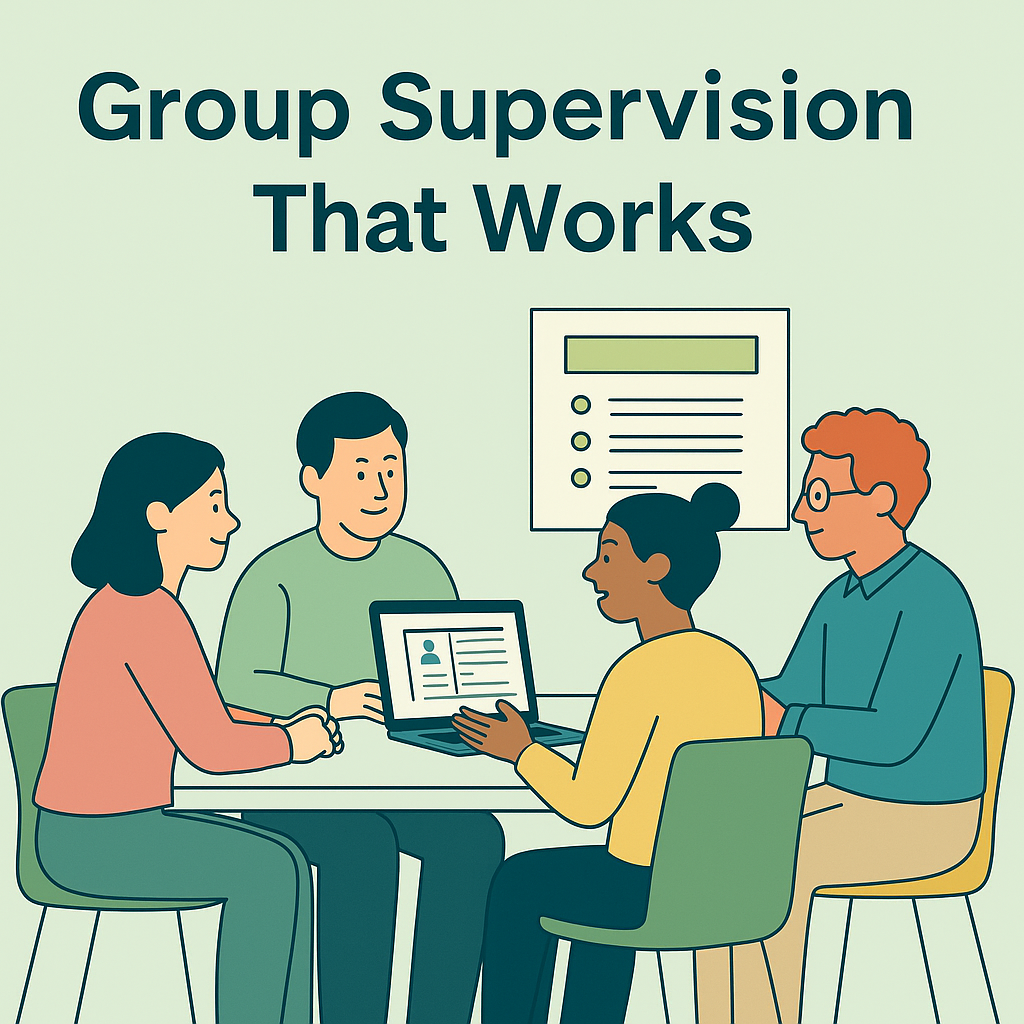How to Structure and Facilitate Effective Group Supervision for ABA Fieldwork
Move beyond passive meetings and build collaborative, high-impact supervision experiences.
Group supervision is a powerful tool in the supervised fieldwork experience—but only if it’s done well. Too often, it turns into a passive lecture or informal check-in, missing the rich potential of peer-driven learning.
As Valentino, LeBlanc, & Sellers (2016) emphasized, “Professionals should view and manage group supervision as a unique and valuable teaching and mentoring experience, rather than simply as individual supervision with more people in the room.”
In this post, we’ll walk through the structure, goals, and activity ideas for group supervision that actually supports growth and competency.
🔹 What Group Supervision IS (and ISN’T)
✅ Group supervision is:
- A space for collaborative learning
- A forum to discuss cases, ethics, or professional challenges
- An opportunity to build clinical reasoning and reflect on decision-making
❌ Group supervision is NOT:
- A lecture or passive training session
- A casual check-in without structure
Group supervision should be intentional, with a clear agenda and outcomes.
🧠 Why Use Group Supervision?
Group supervision offers unique developmental opportunities that complement individual supervision:
- Peer Feedback
- Collegial Support and Networking
- Observational Learning
- Generalization of Concepts
- Professional Repertoire Development (e.g., presenting cases, collaborative decision-making)
When structured thoughtfully, it builds community while sharpening clinical reasoning.

📅 Key Requirements for Group Supervision
According to the BACB®, group supervision must meet the following criteria:
-
No more than 10 trainees per group (regardless of number of supervisors)
-
Group supervision can account for no more than 50% of total supervision hours per month
-
Must include active participation from all trainees
-
May be conducted in person or remotely
📌 What Group Supervision IS (and ISN’T)
✅ Group supervision is:
- A space for collaborative learning
- A forum to discuss cases, ethics, or professional challenges
- An opportunity to build clinical reasoning and reflect on decision-making
❌ Group supervision is NOT:
- A lecture or passive training session
- A casual check-in without structure
Group supervision should be intentional, with a clear agenda and outcomes.
🔁 Repeatable Group Supervision Activities
Here are eight high-impact activities you can rotate across sessions:
- Peer Presentations
A trainee presents a topic of interest, followed by discussion and Q&A.
- Case Consultation
One trainee shares a current challenge and the group problem-solves together.
- Guided Skill Practice
Practice a skill using Behavioral Skills Training (e.g., writing operational definitions).
- Big Picture Discussions
Explore critical thinking questions like "How do we choose a teaching arrangement?"
- Case Study Walkthroughs
Review a mock case with sample data and talk through clinical decisions as a group.
- Resource Shares
Trainees each bring a tool or tip related to a specific topic (e.g., data collection strategies).
- Ethical Dilemmas
Work through an ethical scenario together and discuss next steps.
- Research Breakdowns
Read and analyze a published article and reflect on how it informs practice.
🚧 Common Barriers and What to Do
Even experienced supervisors can face challenges in facilitating group supervision.
Here are some common barriers and solutions:
|
Barrier
|
Solution
|
|
Supervisor prep time
|
Use templates and rotate structured activities
|
|
Uneven trainee engagement
|
Use cold calling, wait time, or reflective prompts
|
|
Variability in skill levels
|
Pair experienced and newer trainees for peer mentoring
|
|
Limited opportunity for feedback
|
Assign products to bring to 1:1s and use rubrics for self-assessment
|
🗂️ How to Facilitate Meaningful Group Supervision
Great group supervision doesn’t happen by accident. Here are four ways to make it stick:
- Share an Agenda in Advance
Help trainees prepare and stay focused with clear goals and topics.
- Establish Group Norms
Set expectations around participation, confidentiality, and professionalism.
- Create a Shared Resource Library
Use a shared folder or dashboard for handouts, tools, and session notes.
- Use a Communication Channel
Stay connected between sessions (Slack, GroupMe, Google Chat, etc.).
💡 Final Thought
Group supervision has the potential to deepen learning, foster collaboration, and develop professional skills in ways 1:1 supervision often can’t. But it only works if it’s structured, facilitated, and interactive.
Start with one or two repeatable activities, get feedback from your trainees, and iterate.
Copyright notice:
This content references materials adapted from Sidekick Learning's supervision resources.
Portions informed by the Behavior Analyst Certification Board® (BACB®). Board Certified Behavior Analyst® Handbook. For official BACB® guidance, visit www.bacb.com.
Valentino, A. L., LeBlanc, L. A., & Sellers, T. P. (2016). The Benefits of Group Supervision and
A Recommended Structure for Implementation. Behavior Analysis in Practice, 9(4), 320–328. WEB link HERE
